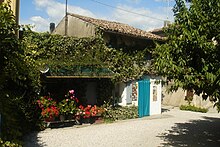Osteria
Osteria is the name for a restaurant in Italy and parts of Switzerland that mainly serves wine and small dishes.
etymology
The name Osteria comes from the old French word for landlord "oste, ostesse", which in turn comes from the Latin ( hospite (m) ) and can therefore be compared with the German "economy". One of the first evidence of the term hostaria can be found in the municipal regulations of the “Signori di Notte” ( Lords of the Night ), who, as the name suggests, watched over the night's sleep in Venice in the 13th century.
history
Similar bars already existed in ancient Rome, called enopolium , while the thermopolium also served hot food and drinks. These were kept in large containers that were set in the counter: well-preserved examples can still be seen in the excavations of ancient Pompeii .
Osterien emerged as rest stops at passageways or in trading places such as streets, intersections, squares and markets, often in modest buildings. They soon developed into meeting places, meeting places and places for social relationships. Wine was an indispensable component around which everything else moved: the food, the guest rooms, the prostitution.
The oldest osteria
In Ferrara , next to the cathedral, there is probably the oldest osteria in the world, the existence of which has been documented as far back as 1435 . The “Hostaria del Chiucchiolino” already existed around 1400, and those who left the church (or wanted to avoid entering) entered the little street next door (today Via degli Adelardi 11) to feast on the good wine on board a barge - the osteria was in a small bay that had formed from rainwater.
There are reports of many illustrious guests of this restaurant, among them the sculptor Benvenuto Cellini , the poets Ludovico Ariosto and Torquato Tasso, and the astronomer Nicolaus Copernicus , who lived and studied above the osteria.
In 1973 Cardinal Stefan Wyszyński , Primate of Poland, and Karol Wojtyła , who accompanied him, were in Ferrara . The occasion was the 500th birthday of the astronomer. In order to enter the living quarters of the famous man, they had to cross the interior of the “Enoteca al Brindisi”, as the oldest osteria is called today.
Ostarias, which serve as restaurants, are now common in Italy and in parts of Switzerland, for example the canton of Ticino .
See also
Web links
swell
- ↑ Newett, Mary Margaret: The Sumptuary Laws of Venice in the Fourteenth and Fifteenth Centuries. In: Historical Essays by Members of the Owens College. London, 1902, pp. 245-278. Here: S: 253.
- ^ Alberghi e ristoranti d'Italia, Touring Club Italiano 2009
- ↑ http://www.gustamodena.it/visite.php?cod=2673
- ↑ Archived copy ( memento of the original from June 19, 2010 in the Internet Archive ) Info: The archive link was inserted automatically and has not yet been checked. Please check the original and archive link according to the instructions and then remove this notice.
- ↑ http://servizi.comune.fe.it/index.phtml?id=3591


